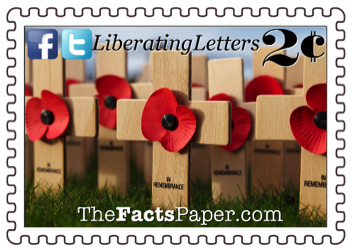November 11, 2018
Dear Liberty,
The ravages of war scarred both the soul and the countryside. Impacted by the loss of life, in a moment of serenity, John looked out across Flanders Fields. It was the site of the Second Battle of Ypres in Belgium where his friend, Lieutenant Alexis Helmer, was killed by artillery fire. As he took a moment to remember his friend and fellow soldiers buried throughout the battlefield, he couldn’t help but notice the sea of red flowers. What he did next became a tribute that has lasted 100 years.
When Canadian Lieutenant Colonel John McCrae participated in the country's first major World War I battle in April of 1915, the war had already been underway for eight months. (see The Shot That Changed The World) As a doctor, he witnessed the horrors and lasting devastation of war up close. Despite the death and destruction, along with the killing of Lt. Helmer, McCrae found hope and inspiration to honor his 6,000 wounded and fallen countrymen in the little red flower covering the makeshift cemetery.
Undisturbed, poppy seeds can remain dormant for upwards of 80 years. However, once the ground is agitated, such as with wartime activities, they start blooming. Because of this, even before “The Great War”, the red poppy symbolized death, renewal, and life. Fields all over the battle zones in Europe were laid waste by shells, gunfire, trenches, and graves. But this havoc led to red poppies blanketing the land.
McCrae grabbed a pen and composed the following poem entitled In Flanders Fields:
In Flanders fields the poppies blow
Between the crosses, row by row,
That mark our place; and in the sky
The larks, still bravely singing, fly
Scarce heard among the guns below.
We are the dead. Short days ago
We lived, felt dawn, saw sunset glow,
Loved, and were loved, and now we lie
In Flanders fields.
Take up our quarrel with the foe;
To you from failing hands we throw
The torch; be yours to hold it high.
If yea break faith with us who die
We shall not sleep, though poppies grow
In Flanders fields.
London’s Punch Magazine published McCrae’s poem on December 8, 1915. In America, editors flooded their magazines and newspapers with reprints of “In Flanders Field” in early 1917. The objective was to build public support as the country's entry into the war became imminent. (see The Day America's Neutrality Sank) In addition, poppies were used on recruiting and War Bond posters.
In November 1918, an American professor wrote another poem as a response to McCrae's.
Oh! you who sleep in Flanders Fields,
Sleep sweet - to rise anew!
We caught the torch you threw
And holding high, we keep the Faith
With All who died.
We cherish, too, the poppy red
That grows on fields where valor led;
It seems to signal to the skies
That blood of heroes never dies,
But lends a lustre to the red
Of the flower that blooms above the dead
In Flanders Fields.
And now the Torch and Poppy Red
We wear in honor of our dead.
Fear not that ye have died for naught;
We'll teach the lesson that ye wrought
In Flanders Fields.
The poem’s author, Moina Michael, was also an American war volunteer and a principle player in making the poppy a symbol for veterans in the U.S. So moved by McCrae’s poem and the flower, Michael wore a red poppy every day until her death. She inspired women to make silk poppies that she and others sold to raise funds for war victims.
Over the next few years, veteran groups adopted the red poppy as their official flower, which the American Legion did on September 27, 1920. (see Unlearned Lessons Of The Bonus March) In 1923, Veterans of Foreign Affairs, or VFW, starting paying disabled and disadvantaged veterans to assemble “Buddy Poppies” to help provide them some income. Their flowers were then sold on Memorial Day and Veterans Day to raise more funds for needy veterans. Patented on May 20, 1924, the VFW's original creation is still made today and sold or passed out for donations.
By November of 1918, the countries part of the Central Powers started signing Armistice agreements. Germany held out for a few days, but they officially laid down their guns at 11:00am on November 11, 1918. General John J. Pershing wanted to keep fighting until a full surrender was obtained, but Democrat President Woodrow Wilson just wanted the war over. (see The Forgotten General) Allies immediately began recognizing Armistice Day, yet after World War II, several countries renamed the holiday and celebrate November 11 as Remembrance Day.
America changed their day of remembrance to May, calling it Memorial Day, and renaming Armistice Day as Veterans’ Day where veterans of all wars are honored on both days. (see Memorial Day: Honoring The Highest Sacrifice and Veterans’ Day) Because of “In Flanders Fields”, artificial flowers called Remembrance Poppies are still part of Remembrance Day/Armistice Day/Veterans’ Day celebrations.
McCrae died of pneumonia on January 28, 1918, without knowing how his poem touched the hearts of so many and inspired a movement to make sure we remember our fallen and wounded soldiers for their sacrifices.
Liberty, on this 100th Anniversary of the silencing of the guns of “The War To End All Wars”, let us give thanks to those who sacrificed for our freedoms and liberty. Likewise, let us pray that we learn to resolve our differences without war.
That’s my 2 cents.
Love,
Mom
IN REMEMBRANCE



